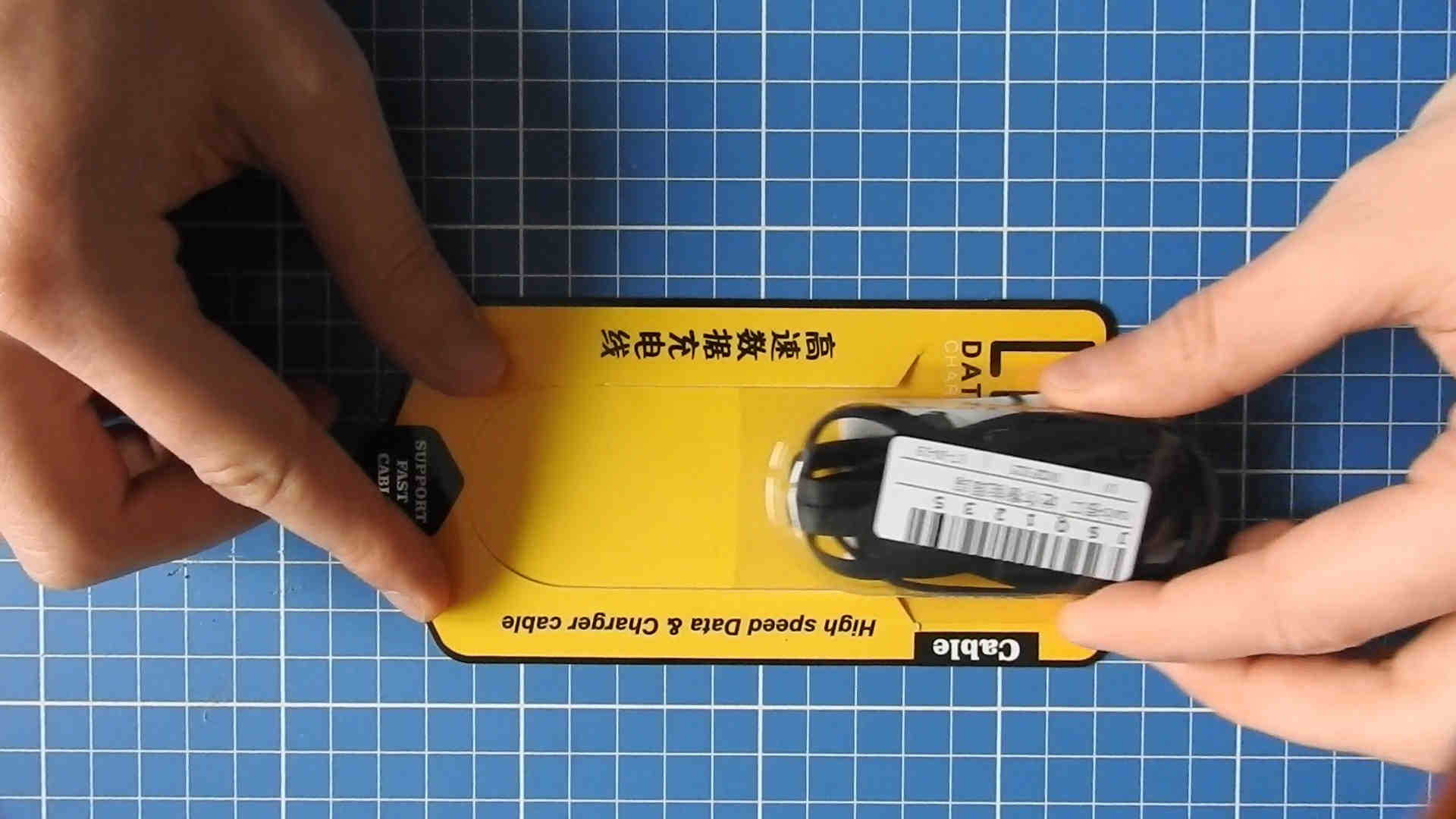
(Published: 2017-11-11, Last update: 2018-01-07)
The following analysis was performed on a S8 data line locator which replied to the hidden SMS command for version query (*3646655*) with:
Ver=MTK6261M.T16.17.01.10
build=2017/01/10 17:33A while back Joe Fitz tweeted about the S8 data line locator1. He referred to it as “Trickle down espionage” due to its reminiscence of NSA spying equipment.
The S8 data line locator is a GSM listening and location device hidden inside the plug of a standard USB data/charging cable. It supports the 850, 900, 1800 and 1900 MHz GSM frequencies.
Its core idea is very similar to the COTTONMOUTH product line by the NSA/CSS [1] in which an RF device is hidden inside a USB plug. Those hidden devices are referred to as implants.
The device itself is marketed as a location tracker usable in cars, where a thief would not be able to identify the USB cable as a location tracking device. Its malicious use-cases can, however, not be denied. Especially since it features no GPS making its location reporting very coarse (1.57 km deviation in my tests). It can, e.g., be called to listen to a live audio feed from a small microphone within the device, as well as programmed to call back if the sound level surpasses a 45 dB threshold. The fact that the device can be repackaged in its sliding case, after configuring it, i.e. inserting a SIM, without any noticeable marks to the packaging suggests its use-case: covert espionage.
The S8 data line locator has several eavesdropping, espionage and spying capabilities. A SMS message log could look like this:
Calling the S8 data line locator for 10 seconds establishes a call and allows you to listen to the microphone feed from the device.
Sending 1111 via SMS to the device enables voice activated call back. It is acknowledged via the following SMS reply:
DT: Set voice monitoring, voice callback and sound sensitivity:400Once the audio level goes above 40 dB the device calls back the number that send the 1111 command.
Sending 0000 disables the audio triggered call back. It is replied by:
DT: Voice monitoring cancelled successfully.Accoding to the manual sending ‘dw’ via SMS to the device yields a reply SMS with the location. This reply is in the form:
Loc:Street, ZIP City, Country
http://gpsui.net/u/xxxx Battery: 100%The ‘xxxx’ are replaced with characters ‘0-9,A-Z,a-z’ and the Street, ZIP City, Country line with the appropriate street, ZIP, city and country. The link to http://gpsui.net can be accessed without authorization. It forwards to Google maps.
The location was never more accurate than 1.57 km off.
During the query the device will use a mobile data connection to an unknown endpoint (presumably gpsui.net). This is confirmed by a “MMS/Internet” charge by my provider. My provider does not discern MMS and Internet, but it is save to assume there is an Internet connection established during location query.
This issue was the stepping stone for this analysis. Because the device sends unknown data to an unknown third party it can not - at least with a clear conscious - be used in, e.g., a penetration test. You simply can not use a potentially pre-owned tool.
I therefore tried to analyze and eliminate this phone-home “feature”.
To gain access to the devices innards we first tear of the metal shield of the USB connector: 
Next, we remove the plastic cover: 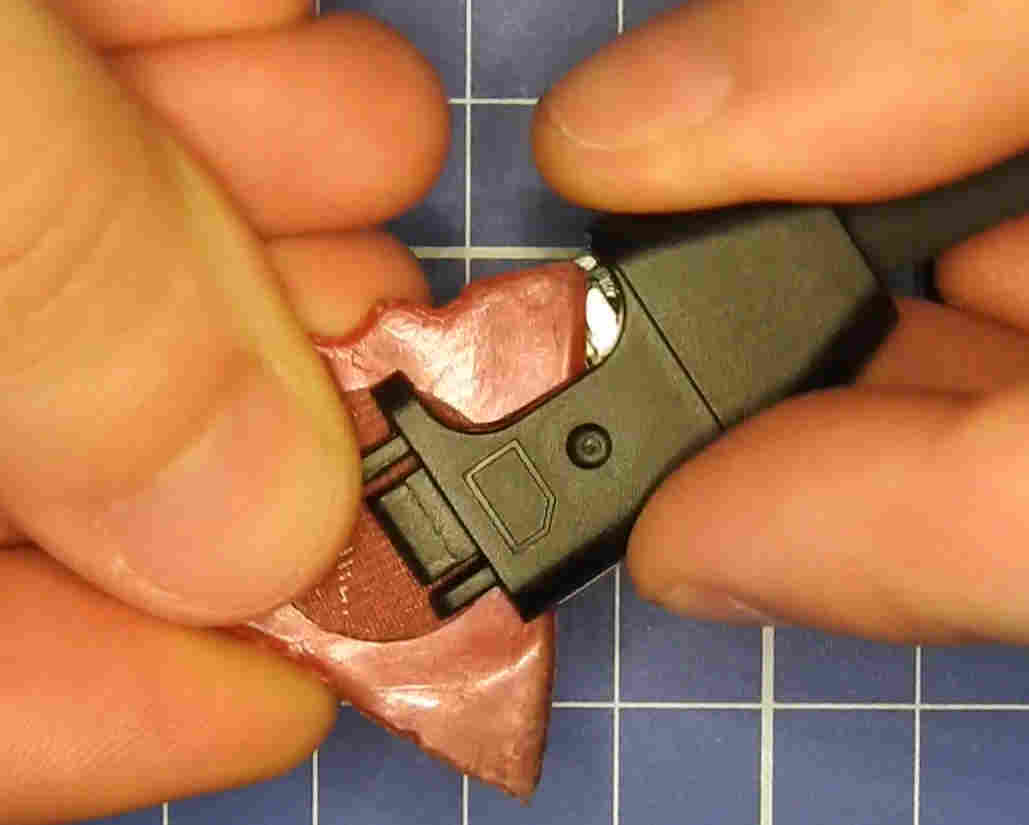
After opening the device we can identify the chips:
It features:
So far I could identify 3 different avenues to connect to the device:
The USB A-connector and the Micro-B cable are not connected to the MT6261MA. They merely pass the signal from one to the other:
The next connection is a UART:
Interfacing with it yields, approximately 3 seconds after booting the device:
screen /dev/ttyUSB0 115200 # 8N1
F1: 0000 0000
V0: 0000 0000 [0001]
00: 1029 0001
01: 0000 0000
U0: 0000 0001 [0000]
G0: 0002 0000 [0000]
T0: 0000 0C73
Jump to BL
~~~ Welcome to MTK Bootloader V005 (since 2005) ~~~
**===================================================**
Bye bye bootloader, jump to=0x1000a5b0
However, the output stops there. Input to the device is ignored.
It is likely there exist a different firmware version that accepts AT modem commands2. The boot banner of that alternate firmware references “ZhiPu”3 (some file names of the FAT12 in the firmware flash of my device contain this string as well, so the device firmware is likely related to that other firmware).
F1: 0000 0000
V0: 0000 0000 [0001]
00: 1029 0002
01: 0000 0000
U0: 0000 0001 [0000]
G0: 0002 0000 [0000]
T0: 0000 0C73
Jump to BL
~~~ Welcome to MTK Bootloader V005 (since 2005) ~~~
**===================================================**
Bye bye bootloader, jump to=0x1000a5b0
LOG: RegisterSn:
LOG: ZhiPu_sock_buf_init malloc= 217780, 217180, 216940
LOG: ZhiPu_mmi_get_imsi_request
LOG: ZhiPu_system_init VERSION= MTK6261M.T16.17.01.10 , build date is 2017/01/10 17:33, curtime 2004-01-01 00:00
LOG: g_zhipu_imei= \
LOG: ----- 0 ----- ----- -268081676 ----- ----- 2 -----
LOG: ZhiPu_sms_ready_sync
LOG: ZhiPu System Language: English
LOG: service_availability= 0,ChargerConnected= 1,poweron_mode= 0
LOG: sim invalid, 4 minutes later reboot
LOG: ----- 0 ----- ----- 83 ----- ----- 2 -----
LOG: idle_screen_network_name:Same IMEIThe DP and DM pads on the USB connector are not connected to the D+ and D- lines of the USB connector. However, the V and GND pads are. The DP and DM pads are instead routed to the MT6261MA processor as illustrated here:
Next, a USB cable must be soldered to these connectors as follows:
The device will then be recognized as an MediaTek phone USB endpoint with the following data:
ID 0e8d:0003 MediaTek Inc. MT6227 phone
This is often called the “MTK boot repair”, “MTK DM DP flash”, etc. It will allow us to interface with the device and dump the firmware ROM and flash.
To dump the firmware I use the open source Fernvale research OS [2]. It was initially targeted for the MT6260 processor. It has, however, been ported to the MT6261 and also works on the MT6261MA.
A suitable fork of fernly by Urja “urjaman” Rannikko can be obtained and build as follows:
git clone https://github.com/urjaman/fernly
git clone https://github.com/robertfoss/setup_codesourcery.git
sudo setup_codesourcery/setup.sh
/usr/local/bin/codesourcery-arm-2014.05.sh
cd fernly
git checkout fernly6261
make CROSS_COMPILE=arm-none-eabi-
exit
cp 95-fernvale-simple.rules /etc/udev/rules.d/.To dump the flash we run:
echo "data = [" > rom.py
fernly/build/fernly-usb-loader /dev/fernvale fernly/build/dump-rom-usb.bin >> rom.py
echo "
]
f = open('rom.bin','wb')
for s in data:
f.write(chr(int(s,16)))
f.close()
" >> rom.py
python rom.pyThe file rom.bin will now (at least according to the fernly repository documentation) contain the devices ROM.
To dump the flash of the device we need to patch flashrom as follows:
git clone https://github.com/flashrom/flashrom
cd flashrom/
git checkout c8305e1dee66cd69bd8fca38bff2c8bf32924306
patch -p0 < ../fernly/flashrom-fernvale.patch
# manually fix Makefile.rej to complete patchingThe patch does not cleanly apply so you need to fix the rejected Makefile (Makefile.rej) manually yourself.
Once this was done we can first load the fernly firmware into the devices RAM via:
fernly/build/fernly-usb-loader -w /dev/fernvale fernly/build/stage1.bin fernly/build/firmware.binNext, we can use the fernvale_spi programmer we patched into flashrom.
We first let it recognize the flash via:
flashrom/flashrom --programmer fernvale_spi:dev=/dev/fernvaleAnd then read the flash via:
flashrom/flashrom --programmer fernvale_spi:dev=/dev/fernvale -c "MX25L3205(A)" --read flash.datflash.dat will now contain the devices flash memory.
Writing the flash can be performed via:
flashrom/flashrom --programmer fernvale_spi:dev=/dev/fernvale -c "MX25L3205(A)" --write flash.datHowever, the flash seems to be block protected and the block protect bits can not be disabled by flashrom. I have not (yet) found a way to disable the block protect.
$ flashrom/flashrom --programmer fernvale_spi:dev=/dev/fernvale
flashrom v0.9.9-86-ge1a960e-dirty on Linux 4.13.2-1.el7.elrepo.x86_64 (x86_64)
flashrom is free software, get the source code at https://flashrom.org
Using clock_gettime for delay loops (clk_id: 1, resolution: 1ns).
Found GigaDevice flash chip "GD25LQ32" (4096 kB, SPI) on fernvale_spi.
No operations were specified.Mostly for my personal education I did some more analysis then the obligatory firmware dump.
First, I sniffed the communication between the device and the SIM. Interestingly, it accessed all records of the telephone book and SMS storage. More specifically it accesses the following files, which are not needed to provide the services rendered by the device itself:
Other SIM accesses seems to be normal.
This is probably not an elaborate scheme to harvest phone numbers and send them to China, but rather the way the default manufactured SIM code was implemented and it was never trimmed down to the needs of this device. Nevertheless, I found it interesting seeing how the device is accessing virtually everything on the SIM.
Next, I tried to sniff the Internet traffic to figure out what is send to whom via the mobile data connection. To this end, I used a Ettus B100 with OpenBTS.
Unfortunately, the S8 data line locator did not connect to the GPRS. This caused the following alternative response to the dw location command:
Loc:Please link:http://gpsui.net/smap.php?lac=1000&cellid=10&c=901&n=70&v=7100 Battery:67%The most interesting things could be found in the dumped flash.
Strings in the flash.dat suggest the device is probably running Nucleus RTOS:
$ strings -a flash.dat
Copyright (c) 1993-2000 ATI - Nucleus PLUS - Version ARM 7/9 1.11.19Other strings that may help identify the OS are:
$ strings -a flash.dat | grep "\.c"
psss\components\src\bl_Secure_v5.c
psss\components\src\SSS_secure_shared_v5.c
hal\system\bootloader\src\bl_Main.c
hal\system\bootloader\src\bl_Main.c
hal\system\bootloader\src\bl_FTL.c
hal\system\bootloader\src\bl_FTL.c
hal\system\bootloader\src\bl_FTL.c
hal\storage\flash\mtd\src\flash_disk.c
hal\system\bootloader\src\bl_Main.c
hal\peripheral\src\dcl_pmu6261.c
hal\system\cache\src\cache.c
hal\peripheral\src\dcl_rtc.c
hal\peripheral\src\dcl_pmu6261.c
hal\system\bootloader\src\bl_FTL.c
hal\system\bootloader\src\bl_FTL.c
hal\peripheral\src\rtc.c
hal\peripheral\src\rtc.c
hal\peripheral\src\rtc.c
hal\peripheral\src\rtc.c
hal\peripheral\src\rtc.c
hal\peripheral\src\rtc.c
hal\storage\flash\mtd\src\flash_mtd_sf_dal.c
hal\peripheral\src\dcl_pmu_common.c
hal\peripheral\src\dcl_f32k_clk.c
hal\peripheral\src\dcl_f32k_clk.c
hal\peripheral\src\dcl_gpio.c
hal\peripheral\src\dcl_pmu_common.c
hal\system\cache\src\cache.c
hal\peripheral\src\dcl_f32k_clk.c
hal\peripheral\src\dcl_gpio.c
hal\peripheral\src\gpio.c
hal\system\bootloader\src\bl_FTL.c
hal\peripheral\src\rtc.c
hal\peripheral\src\bmt_hw.c
hal\peripheral\src\dcl_pmu6261.c
hal\storage\flash\mtd\src\flash_mtd.c
hal\peripheral\src\gpio.c
custom\common\hal\combo_flash_nor.c
hal\peripheral\src\dcl_rtc.c
hal\peripheral\src\dcl_rtc.c
hal\storage\flash\mtd\src\flash_disk.c
custom\common\hal\combo_flash_nor.c
hal\storage\flash\mtd\src\flash_mtd_sf_dal.c
hal\system\emi\src\emi.c
sss\components\src\SSS_secure_shared_common.c
alice.c
ddload.c
plutommi\Framework\GDI\gdisrc\gdi.c
C.cKi
hal\audio\src\v1\audio_service.c
ddload.c
ddload.c
plutommi\Framework\GDI\gdisrc\gdi_image_hwjpg_v2.c
plutommi\Framework\GDI\gdisrc\gdi_image_hwjpg_v2.c
plutommi\Framework\GDI\gdisrc\gdi_util.c
plutommi\Framework\GDI\gdisrc\gdi_util.c
hal\audio\src\v1\audio_service.c
ddload.cUpdate: In my original write up I missed the flash translation layer, hence the FAT12 filesystem was corrupted. Thanks to Bjoern Kerler (@viperbjk) for pointing this out to me. I will work on descrambling the flash and update once I have it working.
For the time being here is my original try at extracting the files from the file system:
Searching the flash.dat for the FAT12 file systems that are supposedly present in on MediaTek phones, we get:
$ hexdump -C flash.dat
002c1e20 00 00 00 00 00 00 00 00 00 ef cd 4e 4f 20 4e 41 |...........NO NA|
002c1e30 4d 45 20 20 20 20 46 41 54 31 32 20 20 20 00 00 |ME FAT12 ..|
002c1e40 00 00 00 00 00 00 00 00 00 00 00 00 00 00 00 00 |................|
002c1e50 00 00 00 00 00 00 00 00 00 00 4d 4d 4d 4d 4d 4d |..........MMMMMM|
002c1e60 4d 4d 4d 4d 4d 4d 4d 4d 4d 4d 4d 4d 4d 4d 4d 4d |MMMMMMMMMMMMMMMM|
*
002c1ff0 4d 4d 4d 4d 4d 4d 4d 4d 4d 4d 4d 4d 4d 4d 55 aa |MMMMMMMMMMMMMMU.|
[...]
002d8400 eb 58 90 46 69 6c 65 53 79 73 20 00 02 01 01 00 |.X.FileSys .....|
002d8410 01 80 00 9b 01 f8 02 00 01 00 01 00 01 00 00 00 |................|
002d8420 9b 01 00 00 80 00 29 00 00 21 30 4e 4f 20 4e 41 |......)..!0NO NA|
002d8430 4d 45 20 20 20 20 46 41 54 31 32 20 20 20 00 00 |ME FAT12 ..|
002d8440 00 00 00 00 00 00 00 00 00 00 00 00 00 00 00 00 |................|
002d8450 00 00 00 00 00 00 00 00 00 00 4d 4d 4d 4d 4d 4d |..........MMMMMM|
002d8460 4d 4d 4d 4d 4d 4d 4d 4d 4d 4d 4d 4d 4d 4d 4d 4d |MMMMMMMMMMMMMMMM|
*
002d85f0 4d 4d 4d 4d 4d 4d 4d 4d 4d 4d 4d 4d 4d 4d 55 aa |MMMMMMMMMMMMMMU.|
[...]
002dbc00 ff ff ff ff ff de 9e 68 00 00 00 00 00 50 ba ff |.......h.....P..|
002dbc10 55 93 00 00 00 00 00 00 00 00 00 00 00 00 00 00 |U...............|
002dbc20 00 00 00 00 00 00 00 00 00 ef cd 4e 4f 20 4e 41 |...........NO NA|
002dbc30 4d 45 20 20 20 20 46 41 54 31 32 20 20 20 00 00 |ME FAT12 ..|
002dbc40 00 00 00 00 00 00 00 00 00 00 00 00 00 00 00 00 |................|
002dbc50 00 00 00 00 00 00 00 00 00 00 4d 4d 4d 4d 4d 4d |..........MMMMMM|
002dbc60 4d 4d 4d 4d 4d 4d 4d 4d 4d 4d 4d 4d 4d 4d 4d 4d |MMMMMMMMMMMMMMMM|
*
002dbdf0 4d 4d 4d 4d 4d 4d 4d 4d 4d 4d 4d 4d 4d 4d 55 aa |MMMMMMMMMMMMMMU.|However, two of the partitions do not appear to be valid FAT12 file systems:
$ fls -o 5646 flash.dat -f fat12
Invalid magic value (Not a FATFS file system (magic))
$ fls -o 5826 flash.dat -f fat12
v/v 6531: $MBR
v/v 6532: $FAT1
v/v 6533: $FAT2
d/d 6534: $OrphanFiles
$ fls -o 5853 flash.dat -f fat12
Invalid magic value (Not a FATFS file system (magic))And the middle FAT12 block seems to be corrupted as well, i.e. only orphan files:
$ fls -o 5826 flash.dat -rp -f fat12
v/v 6531: $MBR
v/v 6532: $FAT1
v/v 6533: $FAT2
d/d 6534: $OrphanFiles
-/r * 469: $OrphanFiles/MP0B_001
-/r * 470: $OrphanFiles/ST33A004
-/r * 471: $OrphanFiles/ST33B004
[...]An attempt was made to extract the files:
fls -o 5826 flash.dat -Frp -f fat12 | while read line; do
path=$(echo "$line" | awk -F':' '{print $2}')
mkdir -p $(dirname $path);
icat -o 5826 flash.dat $(echo "$line" | grep -oE "[0-9]+" | head -n1) > $path
doneBut most files are empty. The results are also very inconsistent, i.e., when changing SIM cards there are significant changes to the files listed by The Sleuthkit. This indicates that those are either not FAT12 partitions or a modified FAT12 variant.
Again as stated at the start of this section I’m missing the flash translation layer (FTL). There are proprietary tools which can do the FTL descrambling for you.
But to keep this whole writeup open source, further analysis was done using hexdump.
The flash also contained some configuration data. First, the IMSI of the inserted SIM and the number that is used to remote control the device could be found in the flash:
$ hexdump -C flash.dat
002e2ad0 00 00 00 00 32 xx xx xx xx xx xx xx xx xx xx xx |....2xxxxxxxxxxx|
002e2ae0 xx xx 37 00 00 01 00 01 00 00 00 00 00 00 00 00 |xx7.............|
002e2af0 00 00 00 00 00 00 00 00 00 00 00 00 00 00 00 00 |................|
*
002e2b10 00 00 00 00 00 00 00 00 00 00 00 2b 34 39 31 xx |...........+491x|
002e2b20 xx xx xx xx xx xx xx xx 00 00 00 00 00 00 00 00 |xxxxxxxx........|
002e2b30 00 00 00 00 00 00 00 00 00 00 00 00 00 67 70 73 |.............gps|
002e2b40 75 69 2e 6e 65 74 00 00 00 00 00 00 00 00 00 00 |ui.net..........|
002e2b50 00 00 00 00 00 00 00 00 00 00 00 00 00 67 70 73 |.............gps|
002e2b60 75 69 2e 6e 65 74 00 00 00 00 00 00 00 00 00 00 |ui.net..........|
002e2b70 00 00 00 00 00 00 00 00 00 00 00 00 00 00 00 00 |................|
*In the above flash segment you can also see a reference to gpsui.net. This is presumably the remote server which is contacted to turn the MCC, MNC, LAI and CID codes into street, city and country information as well as the link to gpsui.net which forwards to Google maps. However, because writing to the flash could not be achieved this hypothesis could not be confirmed.
Eventually, there was a small find potentially making this effort worthwhile. Searching the flash.dat for the dw,1111 and 0000 commands reveals more hidden commands:
$ hexdump -C flash.dat
00069530 8c ae 00 00 8d ae 8e ae 72 65 73 74 6f 72 65 00 |........restore.|
00069540 00 00 00 00 00 00 00 00 01 00 00 00 68 68 68 00 |............hhh.|
00069550 00 00 00 00 00 00 00 00 00 00 00 00 02 00 00 00 |................|
00069560 69 6d 73 69 00 00 00 00 00 00 00 00 00 00 00 00 |imsi............|
00069570 03 00 00 00 74 69 6d 65 7a 6f 6e 65 00 00 00 00 |....timezone....|
00069580 00 00 00 00 04 00 00 00 74 69 6d 65 00 00 00 00 |........time....|
00069590 00 00 00 00 00 00 00 00 05 00 00 00 61 71 65 00 |............aqe.|
000695a0 00 00 00 00 00 00 00 00 00 00 00 00 06 00 00 00 |................|
000695b0 61 71 63 00 00 00 00 00 00 00 00 00 00 00 00 00 |aqc.............|
000695c0 07 00 00 00 73 65 72 76 65 72 00 00 00 00 00 00 |....server......|
000695d0 00 00 00 00 08 00 00 00 64 64 64 00 00 00 00 00 |........ddd.....|
000695e0 00 00 00 00 00 00 00 00 09 00 00 00 72 65 67 00 |............reg.|
000695f0 00 00 00 00 00 00 00 00 00 00 00 00 0a 00 00 00 |................|
00069600 61 71 62 00 00 00 00 00 00 00 00 00 00 00 00 00 |aqb.............|
00069610 0b 00 00 00 71 71 71 00 00 00 00 00 00 00 00 00 |....qqq.........|
00069620 00 00 00 00 0c 00 00 00 64 77 00 00 00 00 00 00 |........dw......|
00069630 00 00 00 00 00 00 00 00 0d 00 00 00 6c 6f 63 00 |............loc.|
00069640 00 00 00 00 00 00 00 00 00 00 00 00 0e 00 00 00 |................|
00069650 66 61 61 00 00 00 00 00 00 00 00 00 00 00 00 00 |faa.............|
00069660 0f 00 00 00 66 66 66 00 00 00 00 00 00 00 00 00 |....fff.........|
00069670 00 00 00 00 10 00 00 00 31 31 31 31 00 00 00 00 |........1111....|
00069680 00 00 00 00 00 00 00 00 11 00 00 00 30 30 30 30 |............0000|
00069690 00 00 00 00 00 00 00 00 00 00 00 00 12 00 00 00 |................|
000696a0 72 70 74 00 00 00 00 00 00 00 00 00 00 00 00 00 |rpt.............|
000696b0 13 00 00 00 67 62 72 70 74 00 00 00 00 00 00 00 |....gbrpt.......|
000696c0 00 00 00 00 14 00 00 00 74 72 61 63 6b 00 00 00 |........track...|
000696d0 00 00 00 00 00 00 00 00 15 00 00 00 6d 6f 6e 69 |............moni|
000696e0 74 6f 72 00 00 00 00 00 00 00 00 00 16 00 00 00 |tor.............|
000696f0 73 6f 73 6f 6e 00 00 00 00 00 00 00 00 00 00 00 |soson...........|
00069700 17 00 00 00 73 6f 73 6f 66 66 00 00 00 00 00 00 |....sosoff......|
00069710 00 00 00 00 18 00 00 00 73 6f 73 00 00 00 00 00 |........sos.....|
00069720 00 00 00 00 00 00 00 00 19 00 00 00 71 63 73 6f |............qcso|
00069730 73 00 00 00 00 00 00 00 00 00 00 00 1a 00 00 00 |s...............|
00069740 6c 65 64 6f 6e 00 00 00 00 00 00 00 00 00 00 00 |ledon...........|
00069750 1b 00 00 00 6c 65 64 6f 66 66 00 00 00 00 00 00 |....ledoff......|
00069760 00 00 00 00 1c 00 00 00 66 6c 69 67 68 74 6f 6e |........flighton|
00069770 00 00 00 00 00 00 00 00 1d 00 00 00 66 6c 69 67 |............flig|
00069780 68 74 6f 66 66 00 00 00 00 00 00 00 1e 00 00 00 |htoff...........|
00069790 65 73 69 6f 6e 6f 77 00 00 00 00 00 00 00 00 00 |esionow.........|
000697a0 1f 00 00 00 65 73 69 6f 61 64 64 72 00 00 00 00 |....esioaddr....|
000697b0 00 00 00 00 20 00 00 00 68 62 74 6f 6e 00 00 00 |.... ...hbton...|
000697c0 00 00 00 00 00 00 00 00 21 00 00 00 68 62 74 6f |........!...hbto|
000697d0 66 66 00 00 00 00 00 00 00 00 00 00 22 00 00 00 |ff.........."...|
000697e0 65 73 69 6f 6c 6f 63 61 74 65 74 79 70 65 00 00 |esiolocatetype..|
000697f0 23 00 00 00 65 65 65 00 00 00 00 00 00 00 00 00 |#...eee.........|
00069800 00 00 00 00 24 00 00 00 73 6e 64 73 74 6f 70 00 |....$...sndstop.|
00069810 00 00 00 00 00 00 00 00 25 00 00 00 64 64 65 00 |........%...dde.|
00069820 00 00 00 00 00 00 00 00 00 00 00 00 26 00 00 00 |............&...|
00069830 66 6f 72 6d 61 74 74 66 00 00 00 00 00 00 00 00 |formattf........|
00069840 27 00 00 00 68 65 6c 70 00 00 00 00 00 00 00 00 |'...help........|
00069850 00 00 00 00 28 00 00 00 2a 65 38 31 2a 00 00 00 |....(...*e81*...|
00069860 00 00 00 00 00 00 00 00 29 00 00 00 2a 65 38 30 |........)...*e80|
00069870 2a 00 00 00 00 00 00 00 00 00 00 00 2a 00 00 00 |*...........*...|
00069880 2a 72 65 62 6f 6f 74 2a 00 00 00 00 00 00 00 00 |*reboot*........|
00069890 2b 00 00 00 2a 33 36 34 36 36 35 35 2a 00 00 00 |+...*3646655*...|
000698a0 00 00 00 00 2c 00 00 00 69 6d 65 69 73 65 74 00 |....,...imeiset.|However, most of those commands do not function correctly. It seems the devices firmware is shared among several such location tracking and listening devices, e.g., there are commands referring to LEDs and a TF card, both of which this device do no feature, however, other devices available online do.
An incomplete list of the found commands and there replies is:
help: replies with the following commands:
dw: Locateqqq: Device binding1111: Sound Alarm Monitor on0000: Sound Alarm Monitor offddd: Reset all tasksaqb: Get Username Passwordeee: Recording saveddde: Cleanup TF cardhhh: Device statusloc: same as dwimsi: Query IMEI and IMSIfaa: “DTMG: Set voice monitoring, SMS reply and sound sensitivity successfully:40”, “DTMG: Unusual sound detected”fff: “DT: Set voice monitoring, voice callback and sound sensitivity successfully:40”1111: “DT: Set voice monitoring, voice callback and sound sensitivity successfully:400”0000: “DT: Voice monitoring cancelled successfully.”gbrpt: “Report:Location the continuous escalation has been closed.”track: “Track:Caller answer mode the device is set to reply location.”hbton: “Hbt:Device is turned on real-time online”hbtoff: “Hbt: Device online has been closed”esionow: “…” ?esioaddr: “Setting esio addr and port fail!”esiolocatetype: “Esio:Reporting location type has been updated to 0.”server: “Setting server addr and port fail!”reg: “…” ?monitor: “Monitor:Caller answer mode the device is set to automatically answer.”eee: “Tf-Card check fails of is insufficient free space!”sndstop: “Cam:No task is running, cancel failed!”*e81*: “…” ?*e80*: “…” ?soson, sosoff, sos, qcsos: ?ledon, ledoff: ?flighton, flightoff: ?aqe: “Setting apn fail!”imeiset: “…” does not seem to set the IMEIrestore: “Restore ok!”formattf: ?time: “…” ?timezone: “Setting time zone ok. Current time zone 0”age: “…” ?*3646655*: queries for version information*reboot*: reboots the deviceInterestingly the reply strings could not be found in the flash in plaintext. This suggests that some of the data is compressed.
The message log of me trying some of the found hidden commands to populate the above list is as follows:
It seems that we can use esioaddr to change the address used to lock up the location information. However, no connection to a given domain nor IP is actually made. The device will simply report the addr invalid in the location report.
The server command sets a different server. Changing it does not result in the addr invalid responses, as can be seen from this second message log:
Because the GPRS sniffing failed I resort to the billing of my provider to further analyze the communication habits of the S8 data line locator.
Obviously reply SMS are billed. More interesting is the Internet access patterns.
dw or loc commands and during idleDuring location queries the device will use “MMS/Internet” service. The following is a segment in which first repeated location queries were performed, then the devices was left idle:
Even during idle the device sometimes uses the “MMS/Internet” service.
Even though I deactivated all tracking features that I may have activated during my previous testing, I can not be 100 % sure that this is not something that I activated, maybe while stumbling through the gpsui.net website. However, I regardless of whether I activated this “feature” or not, I do not want it and would like to know what data is actually send and how to deactivate it.
Going deeper into the gpsui.net website would probably result in a new writeup in itself. It is a very big surveillance hub, just replace the xxxx in http://gpsui.net/u/xxxx with some letters and numbers and you can see random people’s locations.
The website also makes a reference to ZhiPu:
It seems this is the company that makes these trackers.
You can get your credentials for login by texting aqb to your S8 data line monitor. The username as well as the password are 6 digit numbers. They are also located in the flash right before the IMSI.
The web interface allows access to several features, which may or may not work as I’m not interested in them and hence not tested all of them:
The plain interface after login looks like this: 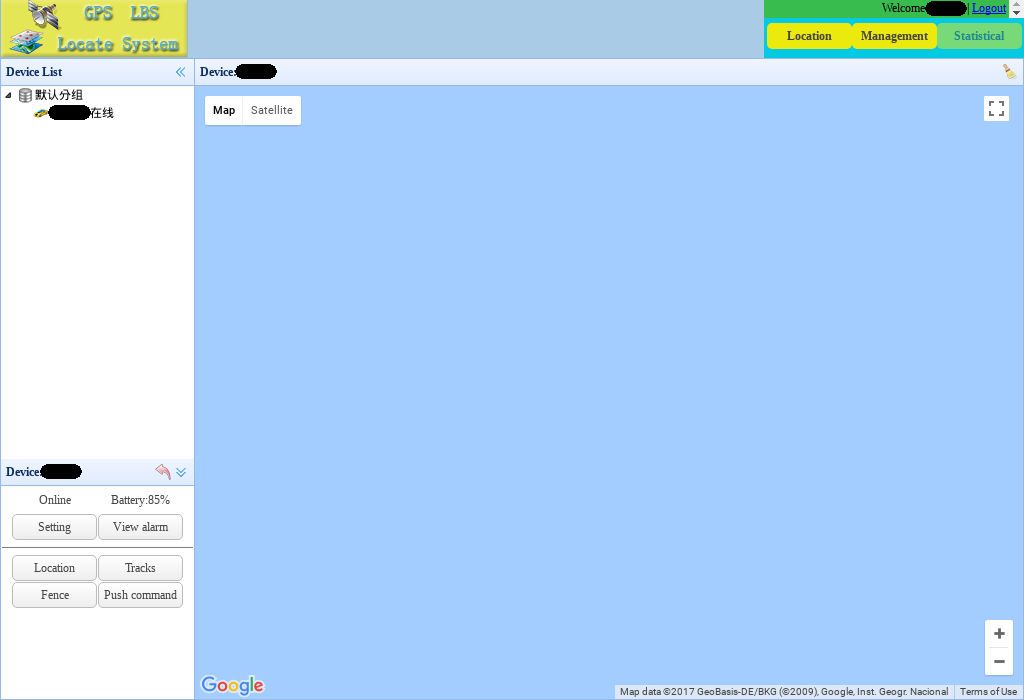
I panned the map into the ocean to hide my location. The location is pinpointed on the map by a little car and a pop up containing the GPS data and date of the last location update.
You can change various settings: 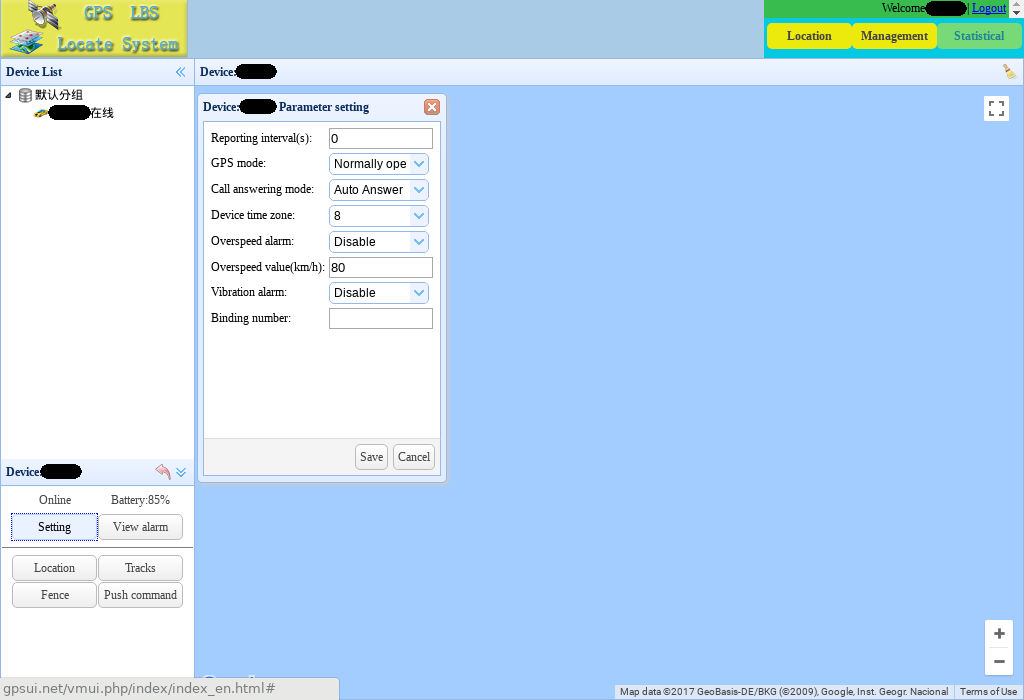
You can enable real time location tracking: 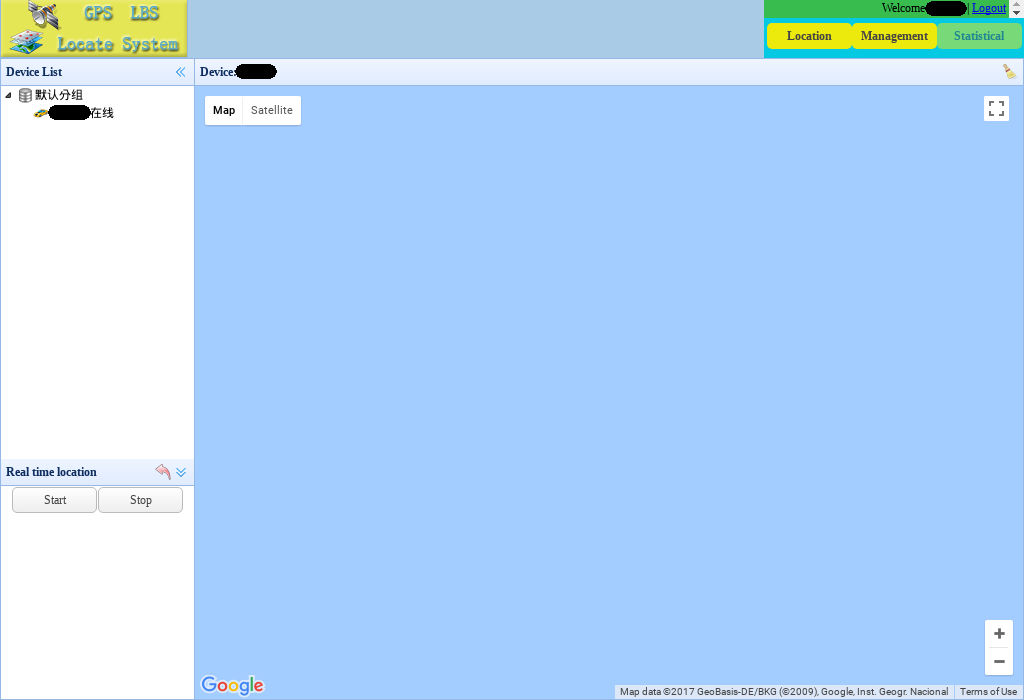
Interestingly, the web interface allows to playback past location queries, as can be seen here: 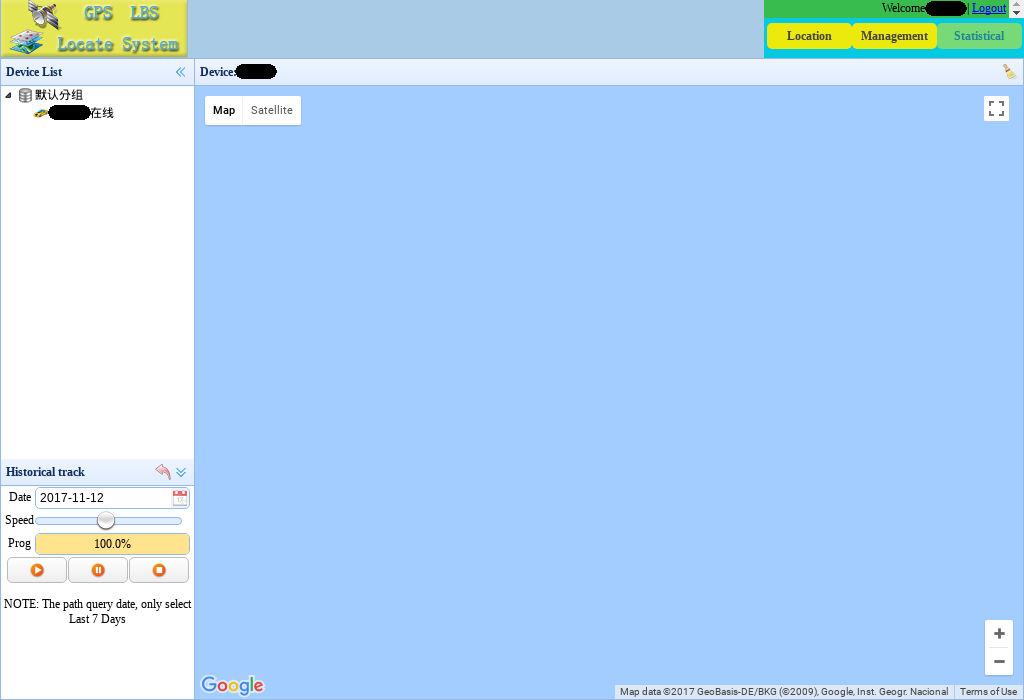
I find this particularity disturbing because in the original manual of the S8 data line locator there is no mention of the login credentials nor a way to get them. Also I did not expect a location query history to be stored somewhere.
It also allows to set a geo fence: 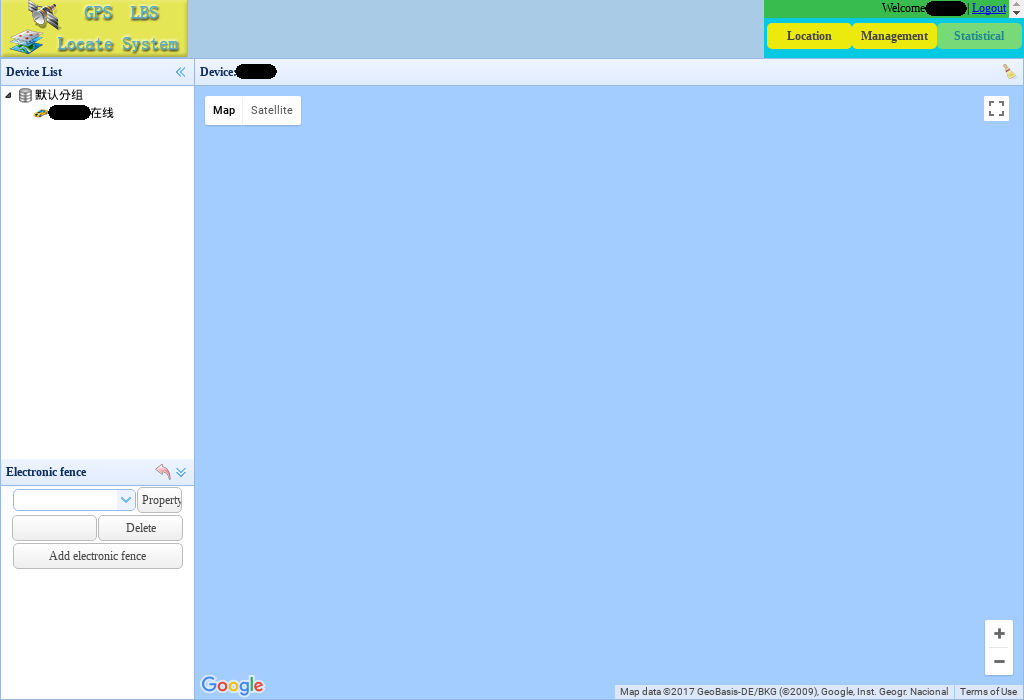
Next, it allows you to push command to the device: 
This means anyone with access to your gpsui.net login credentials can control your device. A device which original packaging nor manual make any reference to said website.
You can also add your fleet of devices into one account for simplified management: 
After publishing this write up, Vangelis Stykas (@evstykas) found a bunch of Insecure Direct Object References with Authorization bypass through user-controlled key vulnerabilities leading to Horizontal escalation of privilege (one user can view/modify information of all other 615,817 accounts) in gpsui.net.
So my initial suspicions about gpsui.net were correct: you do not want your data to be send there.
We then also looked at some other (GPS) location tracking web services. What we found was mildly concerning and you can read about it here: https://0x0.li/trackmageddon/
I just want to point out here that a normal user is (at least as far as I know) never informed about the login credentials to the above website.
Neither is the user informed that the location queries are logged and stored there. Nor that the device can be remote controlled from there.
When sending data the S8 data line locator can be detected with a CC308+ (a cheap Chinese RF detector):
The S8 data line locator seems to be badly shielded. A location request via the dw command causes noticeable electronic noise by the device. It seems in general to cause all sorts of RF interference.
While I did not (yet) succeed with my original goal to disable the mobile data phone home “feature’, it was nevertheless a fun exercise and hopefully someone finds this useful or at least educational.
Future work needs to be done on several things:
I was not able yet to write new firmware via flashrom because I was not able to disable block protection on the flash, yet. Maybe a different avenue for flashing new firmware could be the SPFlash tool4 and/or the Flash tool. However, that would not be open source. If you are able to flash your S8 data line locator please contact me with details!
Further, I tried to capture the GPRS data connection of the device, but was unable to do so. It would not use GPRS when connected to my network. Currently, I do not know how the APN is configured. The SIM trace does not indicate that the EF(ACL) is ever accessed. However, as I found the correct APN configuration stored in the devices flash, this suggests the device acquires this information via a setup SMS by the service provider.
Dremel the board smaller, e.g., you don’t need the USB connector. This way the S8 data line locator could be turned into a “modular” bug that could be placed where ever there is a 5 V 1 A power source.
@dmxinajeansuit: http://n0.lol/em/s8
No writeup would be complete without at least one fuck up. So here it is:
While using the S8 data line locator with OpenBTS I provisioned imaginary numbers. When switching SIM cards I forgot to turn of the voice activated callback.
So long story short, some guy with the number 3333333 listend in on me for 2 minutes:
The number appears to be some sort of “service” number, hence it was an expensive call. But more importantly I did not notice this until I reviewed the logs!
So my resume on these little hardware espionage implants: They are stealthy and dangerous as fuck!
An accompanying video is available at https://www.youtube.com/watch?v=hVOyoIfHA4E
[1] NSA/CSS, “ANT product catalog (USB),” leaked documents (pdf: https://cryptome.org/2013/12/nsa-ant-usb.pdf).
[2] A. “bunnie” Huang and S. X. Cross, “Fernvale: An open hardware and software platform, based on the (nominally) closed-source mT6260 soC,” talk at the 31st Chaos Communication Congress (slides: http://www.bunniefoo.com/fernvale/fernvale-31c3.pdf, video: https://www.youtube.com/watch?v=hpEqDPYtf9s).